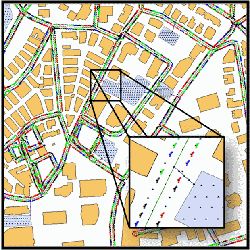
While circling around today’s traffic-choked cities searching for a parking spot is both aggravating and time-consuming, the actual problem can be far greater, accounting for a substantial percentage of noise and air pollution and negatively affecting traffic safety and congestion.
That is why four researchers in Israel and the Netherlands have teamed up to create PARKAGENT, a spatially explicit agent-based software model designed to assess and optimize urban parking policies. Eventually, PARKAGENT might be used to develop a signpost system that directs drivers to vacant parking lots, as well as to build an in-car information service to alert drivers to the likelihood of finding a free spot en route to a particular destination.
Studies in a number of cities have shown that from 8% to 74% of all traffic consists of cars searching for parking, say the researchers. All of that unnecessary driving not only affects traffic safety, but it can also be expensive.
“Estimates for Tel Aviv, for example, show that cruising in just one neighborhood may cost drivers half-a-million dollars annually in lost time and the same in wasted vehicle operation costs,” says professor Itzhak Benenson, one of the four researchers, who is head of Tel Aviv University’s Department of Geography & the Human Environment.
Benenson and Karel Martens, assistant professor of transport planning at Radboud University in the Netherlands, have been working on the project since 2007.
“Our goal has been the assessment and optimization of urban parking policy,” explains Martens. “Every driver is explicitly represented in the PARKAGENT model; they drive toward their destinations just as the real drivers do. At some distance to destination–different for each driver–they start looking for parking. Based on their time budget, willingness to pay, and personal estimates of the distance to destination, the driver decides whether to park at one of the possible places or to continue their search. Having populated the model with numerous drivers, we can investigate the influence of establishing or closing parking lots, increasing or decreasing parking fees, and other changes of the parking regulations in the city. In other words, PARKAGENT makes it possible to test the consequences of parking regulations before implementing them in reality.” [See video demo.]
The two researchers have since been joined by two Ph.D. students: Nadav Levy, who recently incorporated parking inspector agents into the software model, and Geert Tasseron, who is investigating the consequences of drivers’ learning processes.
To date, PARKAGENT has been used by several municipalities, beginning with Tel Aviv which was interested in learning about the impact of adding a new parking garage for residents in an area with a severe shortage of parking.
“Our study showed that the capacity that would be freed on the streets due to cars moving to the new garage would immediately be filled by cars from the area surrounding it, given the lack of parking in the entire area,” recalls Levy. “The average search time in the evening hours would only go down by a few seconds. In short, the impact of additional supply would be very limited.”
In Bat-Yam, Israel, the researchers are currently in the final stages of a complete study of the city’s parking dynamics. “For example, we are using PARKAGENT to assess locations of curb parking that can be turned into public transportation lanes without inducing parking problems or increasing search time,” says Levy.
"Now that the development of the pilot version of PARKAGENT has been completed,” says Benenson, “the next step will be to turn PARKAGENT into a widely used software product in cities around the world.”
Paul Hyman is a science and technology writer based in Great Neck, NY.



Join the Discussion (0)
Become a Member or Sign In to Post a Comment